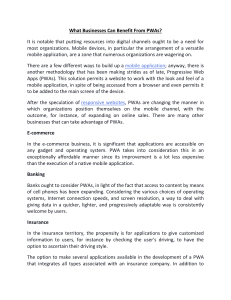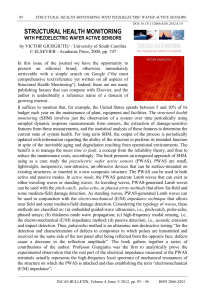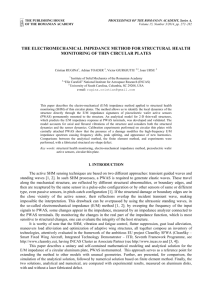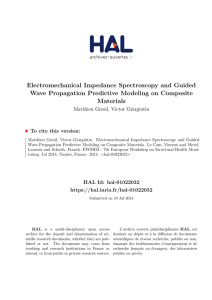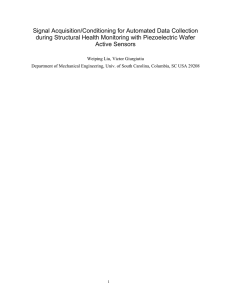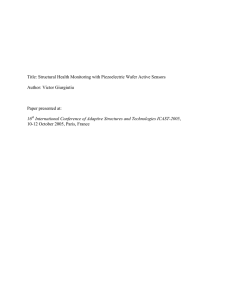THE USER`S GUIDE FOR THE AUTHORS
advertisement
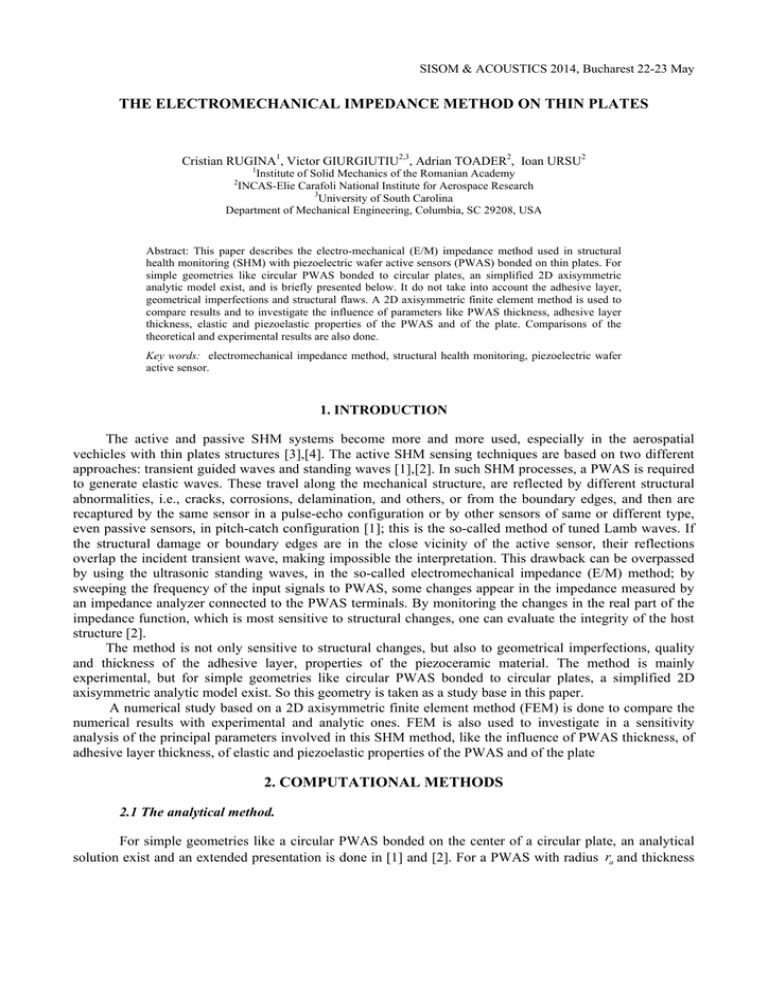
SISOM & ACOUSTICS 2014, Bucharest 22-23 May THE ELECTROMECHANICAL IMPEDANCE METHOD ON THIN PLATES Cristian RUGINA1, Victor GIURGIUTIU2,3, Adrian TOADER2, Ioan URSU2 1 Institute of Solid Mechanics of the Romanian Academy INCAS-Elie Carafoli National Institute for Aerospace Research 3 University of South Carolina Department of Mechanical Engineering, Columbia, SC 29208, USA 2 Abstract: This paper describes the electro-mechanical (E/M) impedance method used in structural health monitoring (SHM) with piezoelectric wafer active sensors (PWAS) bonded on thin plates. For simple geometries like circular PWAS bonded to circular plates, an simplified 2D axisymmetric analytic model exist, and is briefly presented below. It do not take into account the adhesive layer, geometrical imperfections and structural flaws. A 2D axisymmetric finite element method is used to compare results and to investigate the influence of parameters like PWAS thickness, adhesive layer thickness, elastic and piezoelastic properties of the PWAS and of the plate. Comparisons of the theoretical and experimental results are also done. Key words: electromechanical impedance method, structural health monitoring, piezoelectric wafer active sensor. 1. INTRODUCTION The active and passive SHM systems become more and more used, especially in the aerospatial vechicles with thin plates structures [3],[4]. The active SHM sensing techniques are based on two different approaches: transient guided waves and standing waves [1],[2]. In such SHM processes, a PWAS is required to generate elastic waves. These travel along the mechanical structure, are reflected by different structural abnormalities, i.e., cracks, corrosions, delamination, and others, or from the boundary edges, and then are recaptured by the same sensor in a pulse-echo configuration or by other sensors of same or different type, even passive sensors, in pitch-catch configuration [1]; this is the so-called method of tuned Lamb waves. If the structural damage or boundary edges are in the close vicinity of the active sensor, their reflections overlap the incident transient wave, making impossible the interpretation. This drawback can be overpassed by using the ultrasonic standing waves, in the so-called electromechanical impedance (E/M) method; by sweeping the frequency of the input signals to PWAS, some changes appear in the impedance measured by an impedance analyzer connected to the PWAS terminals. By monitoring the changes in the real part of the impedance function, which is most sensitive to structural changes, one can evaluate the integrity of the host structure [2]. The method is not only sensitive to structural changes, but also to geometrical imperfections, quality and thickness of the adhesive layer, properties of the piezoceramic material. The method is mainly experimental, but for simple geometries like circular PWAS bonded to circular plates, a simplified 2D axisymmetric analytic model exist. So this geometry is taken as a study base in this paper. A numerical study based on a 2D axisymmetric finite element method (FEM) is done to compare the numerical results with experimental and analytic ones. FEM is also used to investigate in a sensitivity analysis of the principal parameters involved in this SHM method, like the influence of PWAS thickness, of adhesive layer thickness, of elastic and piezoelastic properties of the PWAS and of the plate 2. COMPUTATIONAL METHODS 2.1 The analytical method. For simple geometries like a circular PWAS bonded on the center of a circular plate, an analytical solution exist and an extended presentation is done in [1] and [2]. For a PWAS with radius ra and thickness Cristian RUGINA, Victor GIURGIUTIU, Adrian TOADER, Ioan URSU 268 ta , and a plate with radius a and thickness h (fig.2.1), the electrical impedance, as a function of the angular frequency of the excitation electrical signal, can be expressed [1],[2]: −1 ⎧⎪ ⎡ ⎤ ⎫⎪ k p2 (1 + va ) J 0 (ϕa ) Z (ω ) = ⎨iωC ⎢1 − k p2 + ⎥⎬ . 2 ϕ a J 0 (ϕ a ) − (1 − va ) J1 (ϕ a ) − χ (ω )(1 + va ) J1 (ϕ a ) ⎦⎥ ⎪⎭ ⎪⎩ ⎣⎢ (1) Fig. 2.1. Circular PWAS constrained by structural stiffness, k str ( ω) . The coefficient k p represents the planar coupling factor, given usually by the PWAS manufacturer, and expressed by: k p2 = 2d312 , s (1 −ν a ) ε11 (2) E 11 The coefficient C represents the electrical capacitance of the PWAS, expressed by: C= ε 33 π ra2 h (3) , ν a represents the Poisson ratio for PWAS, expressed by the ratio of the mechanical compliances coefficients s11E and s12E at zero electric field ( E = 0) : νa = − s12E . s11E (4) ε11 , ε 33 represents the dielectric permittivity at zero mechanical stress (T = 0) , and d31 represents the piezoelectric coupling between the electrical and mechanical variables. The coefficient ϕ a depends on the geometrical dimensions and the longitudinal wave speed cP of the PWAS and is expressed by: ϕa = ω ra cP , cP = 1 ρ s (1 −ν a ) E 11 (5) Of course when mechanical, piezoelectric and dielectric losses cannot be neglected complex values of those coefficients must be taken into account: s11 = s11 (1 − iη ) , ε 33 = s33 (1 − iδ ) , C = C (1 − i μ ) . (6) 269 The electromechanical impedance method on thin plates The coefficient χ (ω ) in eq.1 represent the ratio of the mechanical stiffness of the structure to be monitored and the stiffness of the PWAS: kstr (ω ) χ (ω ) = (7) k PWAS The stiffness of the PWAS, when the frequency spectrum taken into account in the SHM procedure is far from the PWAS resonances (radial, edge, thickness extensional and thickness shear) it can be expressed: ta ra s11 (1 − ν a ) k PWAS = (8) But the stiffness of the structure is different. The frequency spectrum of the excitation signal, is in the range of radial and flexural resonance of the structure. As shown in [1] and [2], it can be described, as the sum of two terms, the first one modeling the radial mode of vibration, while the second term is modeling the flexural mode of vibration of the circular plate with the bonded PWAS, and can be expressed: −1 ⎡ ⎤ ⎡ r R r − a R r H r − r ) dr ⎤ R ( r ) ⎡⎣ 3Ym ( ra ) + ra Ym' ( ra ) ⎤⎦ Ym' ( ra ) ⎥ h ⎢ a k ( a ) ∫0 k ( ) ( a ⎥ k a ⎣ ⎦ 2 ⎢2 , k str (ω ) = ρ a ⎢ ∑ + ∑ ⎥ 2 m −ω 2 + 2 iζ k ωω k + ω k2 −ω 2 + 2 iζ m ωω m + ω 2jw ⎢h k ⎥ ⎣ ⎦ (9) where H represents the Heaviside step function, while the mode shapes Rk ( r ) , for radial vibration mode, and Ym ( r ) , for flexural vibration mode,, expressed by: Rk ( r ) = Ak J 0 ( λk r ) , (10) Ym ( r ) = Bm ⎣⎡ J 0 ( λm r ) + Cm I 0 ( λm r ) ⎦⎤ , (11) form an orthonormal function sets that satisfy the orthonormality conditions ρ h∫ 2π ρ h∫ 2π 0 0 ∫ a ∫ a 0 0 Rk ( r ) Rl ( r ) rdrdθ = ρπ a 2 hδ kl (12) Yp ( r ) Ym ( r ) rdrdθ = ρπ a 2 hδ pm . (13) zk where zk are the a solutions of the equation zJ 0 ( z ) − (1 −ν ) J1 ( z ) = 0 that describe the axial vibration of a circular plate in term For axial vibration of the plate, the coefficients λk from eq. 10 are λk = of Bessel functions and Poisson ratio. The coefficients Ak in eq.10 are Ak = J12 ( zk ) − J 0 ( zk ) J 2 ( zk ) . For flexural vibration of the plate, the coefficients λm from eq. 11 are λm = zm where zm is the a λ 2 J 0 ( λ ) + (1 − v ) λ J 0′ ( λ ) λ 3 J 0′ ( λ ) solutions of the equation 2 = . The coefficients Bm , Cm from eq. 11 are to λ I 0 ( λ ) − (1 − v ) λ I 0′ ( λ ) λ 3 I 0′ ( λ ) be determined numerically from the orthonormality conditions. The angular frequencies ωk , ωm that correspond to the radial and flexural vibrations are: ω k = cL z k = cL ωm = λm2 λk a D Eh3 D = , ρ ha 4 12 (1 − v 2 ) (14) (15) In all the above equations J 0 , J1 represents the Bessel functions of first kind and first and second order, and respectively I 0 , I1 the modified Bessel functions of first kind and first and second order. Cristian RUGINA, Victor GIURGIUTIU, Adrian TOADER, Ioan URSU 270 2.2. The numerical method The numerical model used in this paper is the finite element method, implemented in the software Comsol 4.3. A coupled field frequency analysis based on piezoelectric constitutive equations that include structural losses has been taken into consideration, for the stress-charge formulation,with the following symbol notation, according to Comsol 4.3 User Guide : σ = cE ε − e T E (16) D = eε + ε 0εrS E where σ denotes the stress matrix, ε denotes strains matrix, D denotes electric charge matrix, cE denotes the elasticity matrix, sE denotes the compliance matrix, e denotes the piezoelectric coupling matrix, εr the relative permittivity matrix. In Comsol Multiphysics the ~ symbol denotes complex values where the imaginary part defines the dissipative function of the material: X = X (1 ± jη ) where X η X = imag ( X ) / real ( X ) is the loss factor. The piezoceramic materials belong to the 6mm class symmetry [5], and have compliance, piezoelectric coupling and relative permittivity matrices in the stress-charge form (eq.16): 0 0 ⎞ ⎛ c11 c12 c13 0 0 0 0 e15 0 ⎞ ⎛ 0 ⎜ ⎟ ⎜ ⎟ c c 0 0 0 e=⎜ 0 0 0 e15 0 0 ⎟ ⎡⎣C/m 2 ⎤⎦ 11 13 ⎜ ⎟ ⎜e ⎜ c33 0 0 0 ⎟ 0 0 ⎟⎠ ⎝ 31 e31 e33 0 cE = ⎜ ⎟ [GPa] c55 0 0 ⎟ (17) ⎜ 0 ⎞ ⎛ ε11 0 ⎜ ⎟ ⎜ ⎟ c55 0 ε r = ⎜ 0 ε11 0 ⎟ ⎜⎜ ⎟⎟ ⎜ 0 c66 ⎠ ⎝ 0 ε 33 ⎟⎠ ⎝ c66 = ( c11 − c12 ) / 2 3. EXPERIMENTAL SETUP A comparison of the analytic method and FEM computation with experimental results was done. ra h rb r a b Fig. 3.1. a) Position and geometry of the thin plate with central hole and arc-shape laser fabricated cracks and bonded PWAS. b) Experimental setup used. In the experimental setup, the HP 4194A impedance analyzer was used (fig.3.1.b). The chosen geometry for analytical and experimental comparisons is a circular A2024 aluminum plate with a circular Noliac PCM51 PWAS on it, bonded with the electro-conductive epoxy ELPOX15 (fig.3.1.a); the PWAS material is equivalent to the standard PZT-5A material. The electro-conductive epoxy ELPOX15 was approximated to DieBond silver filled epoxy. 271 The electromechanical impedance method on thin plates The elastic properties of the Aluminum A2024 plate are taken E = 70GPa , ρ = 2700kg / m3 , ν = 0.33 . The elastic properties of the adhesive layer are taken E = 2.99GPa , ρ = 1190kg / m3 , ν = 0.45 . The piezoceramic material of the PWAS used numerical FEM computation is the piezoceramic material PZT5A, that have compliance, piezoelectric coupling and relative permittivity matrices in the stress-charge form (eq 16, eq.17) E = 120.35 [GPa ] , : c11E = c22 c12E = 75.18 [GPa ] , E E c44 = c55 = 21.05 [GPa ] , E c66 = 22.57 [GPa ] , E c13E = c23 = 75.09 [GPa ] , E c33 = 110.86 [GPa] , e31 = e32 = −5.35116 [C / m 2 ] , e33 = 15.7835 [C / m 2 ] , r r = 919.1 , ε 33 e15 = 12.2947 [C / m 2 ] , ε11r = ε 22 = 826.6 The specimen A2024 with bonded PWAS has the geometry (Figs 3.1): r = 50.08 mm, h = 0.835 mm, ra = 4 mm, rb = 1mm. Re(Z) [ 10000 Ω] 10 Re(Z) [ 5 Ω] Experimental 9000 Experimental Analytic Analytic FEM without adhesive FEM without adhesive 8000 10 4 7000 6000 5000 10 3 4000 3000 10 2 2000 1000 0 1 1.5 2 2.5 f [Hz] 3 3.5 4 x 10 4 10 1 1 1.5 2 2.5 f [Hz] 3 3.5 4 x 10 4 Fig. 3.2. Real part of the E/M impedance in the case without defects and without central hole, in linear scale (a), and in logarithmic scale (b). A comparison of the analytic and numerical (FEM) solutions with experiments is done in the frequency range [10kHz, 40kHz] and is given in Fig. 3.2. The input data of the analiyical solution are the geometry and the material properties of the A2024 aluminum plate and PWAS. The key parameters from eq. 9, ζ k = 0.45% ζ m = 0.9% , and from eq. 6 η = 2% , δ = 2% , were chosen to match the theoretical results with the experimental data. a b Fig. 3.3. Real part of the E/M impedance in the case without and with adhesive layer of 20μm, 50μm, 100μm, in linear scale (a), and in logarithmic scale (b). In the numerical 2D axisymmetric FEM simulations it is not possible to take different structural losses for flexural and radial vibration modes. Furthermore the adhesive layer was not taken into consideration in the analytic model. So structural losses of 1% are taken for the A2024 aluminum and for the adhesive layer, and no structural losses for the PWAS. Only dielectric losses of 1.9% in the poling direction for the PWAS are considered in the next FEM simulations. The thickness of the electro-conductive epoxy adhesive layer was measured with a comparator, and was found to be between 20μm and 100μm. A comparative study of the influence of the thickness of the adhesive layer was done and presented in fig.3.3. It can be seen that the frequency of flexural resonance peaks shifts with less than 1%, but the amplitude become gradually significantly smaller, in the presence of an adhesive layer of 20μm, 50μm, Cristian RUGINA, Victor GIURGIUTIU, Adrian TOADER, Ioan URSU 272 100μm, compared to the one without adhesive. For axial vibration the resonance peaks do not shift al all, but the amplitude also become gradually significantly smaller, in the presence of an adhesive layer. a b Fig. 3.4. Real part of the E/M impedance in the case of PWAS thickness of 0.20mm, 0.5mm, 1.0mm, in linear scale (a), and in logarithmic scale (b). Another comparative study of the influence of the thickness of the PWAS was done and presented in figure 3.4. The thickness of the PWAS was taken 0.2mm, 0.5mm, 1mm. The thickness of the adhesive layer is taken constant of 0.5mm. The results shows that the thickness of the PWAS influence significantly not only the frequencies of the resonance peaks, but also their amplitudes. It can be seen that a PWAS of 0.5mm gives bigger amplitudes than the one of 0.2mm and 1.0mm. A too thin or too thick PWAS are too flexible or to stiff to capture the signal. 4. CONCLUSIONS Comparisons between the finite element method, and experimental and analytic results have shown results. The analytic method models E/M impedance only in structures without defects, but it is good for calibrating the basic parameters like elastic and damping properties in inverse methods. The 2D FEM simulations have shown that the adhesive layer influence only slightly the frequencies of the resonance peaks, but significantly the amplitude of these peaks. Also the FEM simulations have shown that the thickness of the PWAS influence both the frequencies of the resonance peaks, and significantly the amplitude of these peaks. It was shown that a medium thickness of the PWAS, so a medium thickness of the PWAS is advised to be mounted in SHM systems. Acknowledgements. The authors gratefully acknowledge the financial support of the National Authority for Scientific Research−ANCS, UEFISCSU, through STAR research project code ID 188/2012. REFERENCES 1. GIURGIUTIU, V., Structural Health Monitoring with Piezoelectric Wafer Active Sensors, Elsevier Academic Press, 2008. 2. ZAGRAI, A., GIURGIUTIU, V., Electro-mechanical impedance method for crack detection in thin plates, Journal of Intelligent Material Systems and Structures, 12, no. 10, pp. 709-718, 2001. 3. URSU, I., TECUCEANU, G., TOADER, A., BERAR, V., Simultaneous active vibration control and health monitoring of structures. Experimental results, INCAS Bulletin, 2, 2, 114-127, 2010. 4. URSU, I., GIURGIUTIU, V., TOADER, A., Towards spacecraft applications of structural health monitoring, INCAS Bulletin, 4, 4, pp. 111-124, 2012. 5. *** IEEE std 176-1987 - Standard on Piezoelectricity, doi: 10.1109/IEEESTD.1988.79638.
